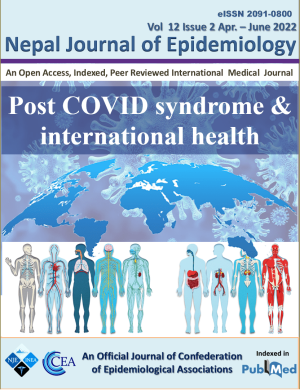Global re-emergence of human monkeypox: Population on high alert
DOI:
https://doi.org/10.3126/nje.v12i2.45974Keywords:
Monkeypox, Rodent Diseases, Poxviridae Infections, DNA Virus Infections, Monkeypox virus, OrthopoxvirusAbstract
The Monkey pox virus is a member of the Orthopoxvirus genus in the family “Poxviridae”. The Orthopoxvirus genus includes Monkey pox, Smallpox (variola virus), the vaccinia virus and the Cowpox virus. The first human case of Monkey pox was recorded in the 1970’s in the (DRC) Democratic Republic of the Congo. Numerous cases of Monkey Pox have been reported to the WHO since the 1st of January 2022. As of the 15th of June 2022, a total of two thousand one hundred and three (2103) confirmed cases and 1 death have been registered by the WHO. Transmission of the Monkey Pox virus occurs through direct contact. Close contact such as that of skin to skin, mouth to mouth and face to face with the exposure to open lesions or lesions of the buccal mucosa aid the transmission of the disease. The virus is also transmitted through contaminated objects and materials ranging from pillows to bedding and the like. The occurrence and spread of this most recent outbreak of the virus has been mainly attributed to the sexual route of transmission. The sexual transmission predominantly occurring in men whom have had sexual relations with other men. Cases infected with Monkey Pox present with a high fever (pyrexia), vesicular and pustular rashes on the palms and soles and lymphadenopathy (lymphadenopathy being the main differentiating fever between Small Pox and Monkey Pox). Currently no licensed treatments are available for individuals infected with Monkey Pox, but brincidofovir and tecovirimat have shown promising use and efficacy against the virus in animals. The treatment is predominantly of the symptomatic type including paracetamol to combat the viral fever. Various medicaments can be used to prevent and control the Monkey Pox outbreak including (VIG) Vaccinia immunoglobulin, cidofovir and the Small Pox vaccine
The current international outbreak of Monkey Pox, is by no means the next SARS-CoV-2 pandemic, however through stronger global surveillance and international collaboration the current up flaring of cases can be swiftly controlled. It is vital that such outbreaks of this virus induce health agencies to begin further research into the Poxviridae family and formulate newer and more effective specific treatments to adequately treat and prevent such events in future.
Downloads
Downloads
Published
How to Cite
Issue
Section
License
Copyright (c) 2022 CEA & INEA

This work is licensed under a Creative Commons Attribution 4.0 International License.
- Upon acceptance Copyright on any research article is transferred in full to the Confederation of Epidemiological Associations (CEA) and International Nepal Epidemiological Association (INEA). The copyright transfer includes the right to reproduce and distribute the article in any form of reproduction (printing, electronic media or any other form).
- Articles in the Nepal Journal of Epidemiology are Open Access articles published under the Creative Commons CC BY License (https://creativecommons.org/licenses/by/4.0/)
- This license permits use, distribution and reproduction in any medium, provided the original work is properly cited.




